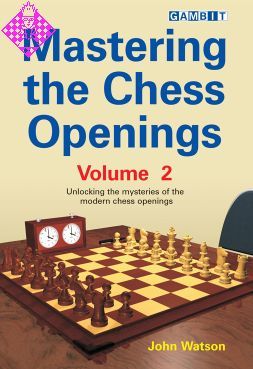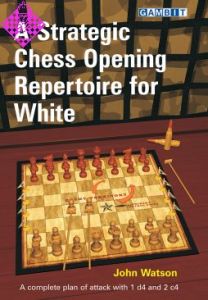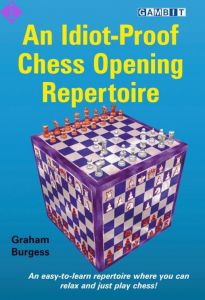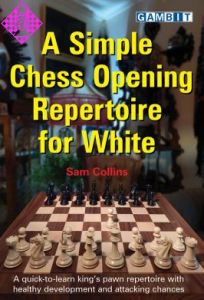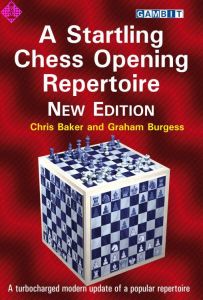Mastering the Chess Openings - Vol. 2
320 Seiten, kartoniert, Gambit, 1. Auflage 2007
For most chess-players, opening study is sheer hard work. It is hard to know what is important and what is not, and when specific knowledge is vital, or when a more general understanding is sufficient. Tragically often, once the opening is over, a player won't know what plan to follow, or even understand why his pieces are on the squares on which they sit. John Watson seeks to help chess-players achieve a more holistic and insightful view of the openings. In his previous books on chess strategy, he explained vital concepts that had previously been the domain only of top-class players. Here he does likewise for the openings, explaining how flexible thinking and notions such as 'rule-independence' can apply to the opening too. Watson presents a wide-ranging view of the way in which top-class players really handle the opening, rather than an idealized and simplified model.
This volume, focusing on queen's pawn openings, is a book that will make chess-players think hard about how they begin their games. It also offers both entertainment and challenging study material in openings such as the Nimzo-Indian, King's Indian and the entire Queen's Gambit complex.
International Master John Watson is one of the world's most respected writers on chess. His groundbreaking four-volume work on the English firmly established his reputation in the 1980s, and he has produced a string of top-quality works since. In 1999, Secrets of Modern Chess Strategy, Watson's first book for Gambit, won the British Chess Federation Book of the Year Award and the United States Chess Federation Fred Cramer Award for Best Book. His pupils include the 1997 World Junior Champion, Tal Shaked.
Introduction
This second volume of Mastering the Chess Openings investigates openings in which White plays 1 d4. As in Volume 1, which examines 1 e4, I work from the ground up, starting with the very first moves of each opening to explain its elementary properties. Someone with only a modicum of playing experience should be able to master these fundamentals and use them as a basis for understanding the more sophisticated material that follows. For a primer on the rudimentary principles that apply to all opening play, please refer to Chapter 1 of Volume 1. The next two chapters of that volume may also be useful, since they identify the ideas and themes most often referred to in the book as a whole.
My philosophy is the same in both volumes, but a few points bear repeating. These books are not meant to cover all openings, much less all of their variations; such an undertaking would require scores of volumes. Instead, I have selected systems that I consider the most useful for the sake of explanation and instruction. In the main, these are the most 'important' openings, in that they have had a large following through the years and have a well-developed theoretical underpinning. Within these major openings I have picked a number of variations to study in some detail, based upon the belief that in-depth familiarity with several variations is better than superficial understanding of all. In order to place this selection in context, I leave signposts to indicate the direction in which alternatives may lead.
While some of the games and analysis are recent, many classic examples are used to illustrate general points.
This is not primarily a theoretical tome: some of the opinions that I venture about the value of hotly-contested individual lines will undoubtedly prove wrong or irrelevant. Instead, my goal is to provide a solid basis for the reader to play openings successfully, emphasizing positional features and techniques that extend to variations beyond those at hand. Notice that this differs from a full explanation of an opening using concepts specific to that opening. We shall see that individual moves themselves express ideas, whether or not they fit into a general scheme that has previously been set forth. Accordingly, a certain level of detail is absolutely necessary to understand both the consistent strategies and the anomalies that can render such strategies irrelevant.
On a practical level, I have subjected readers to recitations about the niceties of move-orders; the associated issues can be confusing but bear a direct relation to real-world results. Assessments of variations can evolve very rapidly, but how one best arrives at the desired starting points tends not to change much.
In the next chapter I examine the fundamental characteristics of 1 d4 and how it differs from 1 e4. You will find further comparisons between these moves in both volumes. The study of 1 d4 by itself will suffice to improve your chess understanding by leaps and bounds, but if you truly aspire to master the game you will want to know as much as possible about the e-pawn openings as well. I sincerely hope that these volumes will help you in both respects.
Bibliography Periodical Publications
ChessBase Magazine (up to no. 113); ChessBase
New in Chess Magazine; New in Chess
Informator (up to no. 96); Sahovski Informator
Websites
ChessPublishing; Kosten, A.; http://www.chesspublishing.com
The Week in Chess (up to no. 608); Crowther, M; http://www.chesscenter.com/twic/twic.html
Jeremysilman.com; Silman, J.; http://www.jeremysilman.com
ChessCafe.com; Russell, H.; http://www.chesscafe.com
CDs and DVDs
Breutigam, M.; King's Indian with h3; ChessBase 2002
Breutigam, M.; The Chigorin Defence; ChessBase 2001
Corr Database 2006; ChessBase 2006
Dreev, A.; Meran Variation; ChessBase 2002
Henrichs, T.; Queen's Gambit Orthodox Defence - Exchange Variation D31/D35-D36; ChessBase 2005
Kasparov, G.; How to Play the Queen's Gambit (DVD); ChessBase 2005
Milov, V.; Nimzo-Indian - 4 f3 and Sämisch Variation; ChessBase 2002
Neven, K.; The Grünfeld; ChessBase 2004
Neven, K.; Classical Nimzo-Indian - 4 Qc2; ChessBase 2005
Opening Encyclopaedia 2005; ChessBase 2005
Ripperger, R.; How to Play the Nimzo-Indian?; ChessBase 2002
Rogozenko, D.; The Slav Defence; ChessBase 2002
Books and Articles
Aagaard, J.; Queen's Indian Defence; Everyman 2002
Bosch, J.; Secrets of Opening Surprises 1-5; New in Chess 2003-6
Bronstein, D.; Bronstein on the King's Indian; Everyman 1999
Bronznik, V.; The Chigorin Defence (English version); Kania 2005
Burgess, G.; The Slav; Gambit 2001
Collins, S.; Understanding the Chess Openings; Gambit 2005
Cox, J.; Starting Out: 1 d4!; Everyman 2006
Emms, J.; Starting Out: The Queen's Indian; Everyman 2004
Emms, J.; Easy Guide to the Nimzo-Indian; Gambit/Cadogan 1998
Emms, J., Ward, C. & Palliser, R.; Dangerous Weapons: The Nimzo-Indian; Gloucester 2006
Fine, R.; The Ideas Behind the Chess Openings [3rd Edition]; McKay 1989
Gallagher, J.; Starting Out: The King's Indian; Everyman 2002
Gallagher, J.; Play the King's Indian; Everyman 2005
Gligoric, S.; Play the Nimzo-lndian; Pergamon 1985
Golubev, M.; Understanding the King's Indian; Gambit 2006
Hansen, Ca.; The Nimzo-Indian: 4 e3; Gambit 2002
Kallai, G.; More Basic Chess Openings [1 d4]; Cadogan 1997
Krnic, Z. (ed.); ECO D - 3th Edition; Sahovski Informator 1998
Krnie, Z. (ed.); ECO E - 3th Edition; Sahovski Informator 1998
Lalic, B.; Queen's Gambit Declined: Bg5 Systems; Gambit/Everyman 2000 .
Nunn, J., Burgess, G., Emms, J. & Gallagher, J.; Nunn 's Chess Openings; Gambit/Everyman 1999
Nunn, J.; Grandmaster Chess Move by Move; Gambit 2006
Nunn, J. & Burgess, G.; New Classical King's Indian; Batsford 1997
Nunn, J. & Burgess, G.; Main Line King's Indian; Batsford 1996
Palliser, R.; Play 1 d4!; Batsford 2005
Palliser, R.; The Modern Benoni Revealed; Batsford 2004
Panczyk, K. & Ilczuk, J.; The Cambridge Springs; Gambit 2002
Pedersen, S.; The Meran System; Gambit 2000
Rowson, J.; Understanding the Grüinfeld; Gambit 1999
Sadler, M; Queen's Gambit Declined; Everyman 2000
Shaw, J.; Starting Out; The Queen's Gambit; Everyman 2002
Vaisser, A.; Beating the King's Indian Defence and Benoni; Batsford 1997
Ward, C; Starting Out: The Nimzo-Indian; Everyman 2002
Ward, C; The Controversial Sämisch King's Indian; Batsford 2004
Watson, J.; Secrets of Modern Chess Strategy; Gambit 1998
Watson, J.; Chess Strategy in Action; Gambit 2003
Watson, J. & Schiller, E.; How to Succeed in the Queen Pawn Openings; Trafford 2005
Watson, J.; The Gambit Guide to the Modern Benoni; Gambit 2001
Watson, J.; The Unconventional King's Indian Defense; Hypermodern 1999
Yakovich, Y.; Play the 4 f3 Nimzo-Indian; Gambit 2004
Yermolinsky, A.; The Road to Chess Improvement; Gambit 1999
Yrjola, J. & Telia, J.; The Queen's Indian; Gambit 2003
| Gewicht | 580 g |
|---|---|
| Hersteller | Gambit |
| Breite | 17,2 cm |
| Höhe | 24,8 cm |
| Medium | Buch |
| Erscheinungsjahr | 2007 |
| Autor | John L. Watson |
| Sprache | Englisch |
| Auflage | 1 |
| ISBN-10 | 1904600697 |
| ISBN-13 | 9781904600695 |
| Seiten | 320 |
| Einband | kartoniert |
| Name | Gambit Publications Ltd. |
|---|---|
| Adresse | 27 Queens Pine, Bracknell Berkshire RG12 OTL Großbritannien |
| Internet | www.gambitbooks.com |
| info@gambitbooks.com |
Verantwortlicher Importeuer:
| Name | Schachversand Niggemann |
|---|---|
| Adresse | Schadowstraße 5 48163 Münster Deutschland |
| info@schachversand.de | |
| Internet | www.schachversand.de |
005 Symbols
06 Bibliography
008 Introduction
Section 1: Closed Games
0112 Queen's Gambit Declined
012 Declining the Gambit: Other 2nd Moves
023 Early Commitment
025 Classical Variations
025Lasker Defence
029Orthodox/Capablanca Defence
035Tartakower Variation
042Alatortsev Variation
046 Exchange Variation
053Carlsbad Variation
061Modern Exchange
066 Move-Orders in the Queen's Gambit Declined
0703 Slav and Semi-Slav
074 Slav Main Line
076Dutch Variation: 6 e3
086Modern Line with 6 Ne5
094 Exchange Slav
097 Semi-Slav
102The Meran
110Anti-Meran (6 Qc2)
Section 2: Indian Systems
1165 Nimzo-Indian Defence
118 Sämisch and Related Lines
120Lines with ...d6 and ...e5
122Lines with ...d5 and the Botvinnik Approach
135 4 e3 and the Hübner Variation
135Early Castling
1384...c5 and the Hübner Proper
143 Classical Nimzo-Indian: 4 Qc2
143Central Counter-Attack: 4...d5
154Classical with 4...0-0
1646 Queen's Indian Defence
164 Introduction to 3 Nf3
165 Fianchetto Variation
166The Classical 4...Bb7
169The Modern 4...Ba6
173 Petrosian System (4 a3)
1837 King's Indian Defence
188 Four Pawns Attack
191Central Break
2016...Na6 vs the Four Pawns
204 Classical King's Indian
205Exchange Variation
208Strongpoint Variation
216 The Classical Main Line with 7...Nc6
2189 Ne1
238 Averbakh Variation
240 Sämisch Variation
241Sämisch with ...e5
244Sämisch with ...c5
2488 Griinfeld Defence
249 Exchange Variation
2497 Be3 with 8 Qd2
2537 Bc4 and the Classical Exchange
268Modern 7 Nf3 System
272Modern Main Line with Rb1
280 Russian System
2909 Modern Benoni
294 Classical Main Line
301 Pawn-Storm Systems
302Mikenas Attack
303Taimanov Attack
309 Fianchetto System
316 Index of Players
319 Index of Openings
International chess master John Watson, the master of explanations, concentrates in this second volume of "Mastering the chess openings" on the Queens Gambit Declines lines, Slav and Semi-Slav lines, Nimzo-Indian defence, Queen’s Indian defence , Grünfeld Defence and the Modern Benoni. In big lines Watson goes for typical play above latest developments but he covers in these 319 pages an unbelievable amount of complete games and instructive explanations. For example the King’s Indian four pawn attack is well filled with around sixteen and a half pages of text and he gives to the reader more explanations than moves! The book is overloaded with instructive text but it is for example very interesting to pick out something as in the King's Indian defence where Watson sees nothing in the Gunderam attack (1.d4 Nf6 2.c4 g6 3.Nc3 Bg7 4.e4 d6 5.f4 0-0 6.Nf3 c5 7.d5 e6 8.Be2 exd5) 9.e5, named after the German gambit player Gerhart Gunderam (1904-1992) who was the inventor of this line but it is also known as Florentine Gambit and very popular under the local chess scene. But first some words from Watson: "9.e5 is still being played and has been analysed for years. In most examples it is a classic case of overextended pawns. The easiest road to some advantage is 9 ... .Ne4 10.cxd5 Nxc3 11.bxc3 Nd7 12.0-0 dxe5 13.Kh1 e4 14.Ng5 Nf6 15.Bc4 h6 16.Nh3 Bf5 Ruhrberg - Kopp,Hessen 1992" but Watson gives in the book some more possibilities but I like this one its most. Konikowski & Soszynski give in their book "The Fearsome four pawns attack" as alternative 10.Nxd5!? but Watson waves it all away with 10 ... Nc6 11.Bd3 f5 12.exf6 and 12... Nxf6 favours black. Many positions in this book get an important turn from Watson as the explanation of the Russian system in the Grünfeld defence 1.d4 Nf6 2.c4 g6 3.Nc3 d5 4.Nf3 Bg7 5.Qb3 dxc4 6.Qxc4 0-0 7.e4 altogether good for nearly three pages of his book where the notes after 7 ... Nc6 are very interesting seen the influence of computer analysis. Watson: "Most players find 7 ... Nc6 a little hard to believe at first, since it walks directly into d5 now or later." That was the conventional wisdom for some years until, armed with computer analyses, some players decided that a knight on a5 (for that is where it’s headed after d5) would be in no great danger, and that its influence over the board will be significant if black can open the c-file by means of ..c6. Such a modern view of flank knights is not so unusual. Black is saying: ”I don’t care where my pieces end up as long as I can break up your centre.”So it is clear that Watson digs deeper in this book than only on the vital concepts of modern play!Conclusion: Buy it for the highly instructive explanations from John Watson!
With kind permission of the author John Elburg (www.chessbooks.nl)
Was die allgemeine Beurteilung des vorliegenden Werkes angeht, könnte im Grunde an dieser Stelle annähernd der gleiche Text stehen, den Sie Anfang des Jahres in der RE-Februarausgabe auf Seite 65 nachlesen konnten. Dort ging es um die Besprechung des ersten Bandes der Reihe "Mastering The Chess Openings", der sich ausschließlich mit Offenen bzw. Halboffenen Spielen beschäftigt. Die damals seitens Ihres Rezensenten geäußerten Eindrücke, ausnahmslos positiver Natur, lassen sich ohne Abstriche auch auf den vorliegenden Nachfolgeband übertragen, der sich nun den Abspielen nach 1.d4 widmet. Insofern mag zur Vermeidung von Wiederholungen die vorliegende Rezension weniger umfangreich ausfallen als gewöhnlich.
Auch diesmal geht es dem Autor John Watson darum, grundsätzliche Einsichten und systemtypische Cha-rakteristika zu vermitteln, anstatt dem Leser Variantenvollständigkeit zu präsentieren. Dies bedeutet z.B., dass Verfechter des Angenommenen Damengambits ihre Lieblingseröffnung vermissen werden, und auch anderes musste außen vor bleiben, um dem Konzept der Reihe Rechnung zu tragen: Mut zur Lücke in Sachen Variantenfülle, nicht aber hinsichtlich der didaktischen Unterweisung, die in Sachen Gründlichkeit wiederum kaum zu übertreffen ist. Theoriefreaks dürften neben 1.d4 d5 2.c4 dxc4 womöglich auch das Anti-Meraner-Gambit sowie Katalanisch vergeblich suchen, aber wie schon mehrfach erwähnt, geht es dem Autor primär um Einsichtsvermittlung, um das Exemplarische.
Als Fazit mag die Feststellung genügen, dass die intensive Beschäftigung mit diesem sowie dem vorangehenden Band dazu ermutigt, auch außerhalb des Gewohnten dem eigenen Verstand zu vertrauen. Der Leser wird in den Stand gesetzt, sich auch auf unbekanntem Terrain zurechtzufinden, während reine Variantensammlungen häufig den Sinn für das Wesentliche verstellen, eine Gefahr, der vor allem Spieler unterer Leistungsklassen häufig erliegen. Dass bessere Detailkenntnisse in der Eröffnungsphase so etwas wie eine Siegesgarantie darstellen, ist nämlich immer noch ein weit verbreiteter Trugschluss.
E. Carl, Rochade Europa 7/2007
______________________
Zum Autor:
Der Internationale Meister John Watson ist einer der renommiertesten Schachautoren auf der Welt. Mit seinem bahnbrechenden vierbändigen Werk über die Englische Eröffnung festigte er in den 80er Jahren seinen Ruf und hat seitdem eine Reihe hochklassiger Bücher verfasst. Im Jahre 1999 wurde Watsons erstes Buch für den Gambit-Verlag "Geheimnisse der modernen Schachstrategie" von der britischen Schachföderation als "Buch des Jahres" und von der Schachföderation der USA mit dem Preis für das beste Buch ausgezeichnet. Zu seinen Schülern gehört der Juniorenweltmeister von 1997, Tal Shaked.
Inhalt:
"Wenn die Eröffnungsphase vorüber ist, weiß ein Spieler tragischerweise oft nicht, welchem Plan er folgen soll oder warum sich seine Figuren auf den Feldern befinden, auf die er sie gezogen hat.“ ...
Im Grund genommen hat Watson mit seinem “Mastering the Chess Openings“ eine Art Ergänzungsbuch zu allen bisherigen erschienenen Eröffnungsbüchern geschrieben; viele andere Eröffnungsbuchautoren sollten, bevor sie wieder mit dem Gedanken spielen ein neues Werk zu veröffentlichen, einen Blick in vorliegendes Buch (und Volume 1!) werfen.
1.d4 Sf6 2.c4 g6 3.Sc3 Lg7 4.e4 d6 5.Sf3 0-0 6.Le2 e5 7.0-0 Sc6 8.d5 Se7 9.Se1 Se8 10.Le3 f5 11.f3 f4 12.Lf2 h5 13.c5 g5 14.a4 Sg6 15.a5 Tf7 16.cxd6 Sxd6! 17.Sd3 Lf6 18.Sc5 Sf8 19.Sb5 Tg7 20.a6 bxa6 21.Sxa6 g4! 22.Sxa7 g3 23.Lc5 Lh3!! 24.gxh3 Dd7 25.Ld3 Dxh3 26.De2 Sg6 27.Dg2 Dd7 28.Sxc7 Sh4 29.De2 Dh3 30.Se6 Sg2!! 31.Tfc1 Dxh2+ 32.Kf1 Dh1+ 33.Lg1 Sh4 34.Sxg7 Sxf3 0-1
Fazit:
Das 320-Seiten Buch hat mich voll und ganz überzeugt! Watson hat das Kunststück fertig gebracht, die wichtigsten Eröffnungen nach 1.d4 übersichtlich und in die Tiefe gehend zu analysieren ohne das Gesamtkonzept aus den Augen zu verlieren. Das Werk wird auch in ferner Zukunft nichts an Aktualität einbüßen; wenn Watson dem Leser auf fast 8 Seiten zum Beispiel die Sämischvariante im Königsinder näher erläutert, spürt man das erhabene Gefühl, einen wahren Klassiker in Händen zu halten. Vielleicht klingt es ein wenig übertrieben aber ich halte John Watson für eine Art modernen Aaron Nimzowitsch. Wie Nimzowitsch, so schreibt auch Watson Bücher, aus denen nachfolgende Generationen von Schachliebhabern ihren Nutzen ziehen können. Uneingeschränkt empfehlenswert.
Mit freundlicher Genehmigung
Martin Rieger, www.freechess.de
---------------------------------------
Der als Autor bereits sehr erfolgreiche Internationale Meister Watson ist vielen Lesern sicher durch seine Titel: "Secrets of Modern Chess Strategy" und "Chess Strategy in Action" ein begriff. Hier versucht er, in seiner bewährten Weise dem Leser die Eröffnungstheorie in einer vernünftigen Weise nahezubringen.
"John Watson seeks to help chess-players achieve a more holistic and insightful view of the openings. In his previous books on chess strategy, ... , he explained vital concepts that characterize modern Chess. Moreover, he did so in ways that have enabled these ideas to be understood by club players. Here he do this likewise for the openings, explaining not only the ideas and strategies behind specific openings, but also the interconnections of chess openings taken as a whole. Watson provides a permanent basis for playing openings of any type."
Dieser Auszug aus dem Rückentext trifft voll zu. Es handelt bei Watsons Buch nicht um die von früher bekannten Theoriesammlungen in ein oder zwei Bänden (z.B. aus der Schachverlag Eröffnungsreihe oder den Kallei) mit Variantensammlung, sondern um eine wirkliche Einführung in die jeweiligen Eröffnungen.
Das Buch ist wie folgt unterteil:
Section 1: Closed Games
2. Queen's Gambit Declined (S.11-69)
3. Slav and Semi-Slav (S.70-113)
Section 2: Indian Systems
5. Nimzo-Indian Defence (S.116-163
6. Queen's Indian Defence (S.164-182
7. King's Indian Defence (S.183-247)
8. Grünfeld Defence (S.248-289)
9. Modern Benoni (S.290-315)
und zum Schluß ein Index der Eröffnungen und Spieler.
In "Introduction to d4 and the Closed Games" geht Watson zunächst allgemein auf die Grundlagen der Geschlossenen Systeme ein. Das ist besonders für Schachfreunde sehr gut, die noch wenig Erfahrung mit diesem Bereich haben und ermöglicht einen besseren Einstieg in die Theorie. Dann folgt "Queen's Gambit Declined", das wir uns als Beispiel für den Aufbau des Buches stellvertretend für die anderen Kapitel einmal näher anschauen. Nach einer zweiseitigen Einführung ins abgelehnte Damengambit folgt "Declining the Gambit: Other 2nd Moves". Hier werden Marshall Defence, Baltic Defence, Albin Counter Gambit und Chigorin Defence vorgestellt. Anders als bei den derzeit marktüberflutenden Repertoirebänden wird also dem Leser das ganze Spektrum der Möglichkeiten vorgestellt, nicht nur ein willkürlich gewählter Ausschnitt. In "Classical Variations" folgt nach der "Lasker Defence" die erläuternde Partie Karpow - Jussupow, London 1989, ab 13...e5. Die Partie Kramnik - Kasparow, Las Palmas 1996, erläutert die Fortsetzung 13...b6 !?. (Die genaue Anzahl der Partien ist leider nicht angegeben, aber der Index der Spieler umfaßt mehr als zwei Druckseiten, enthält also bestimmt weit über Hundert Partien.)
Und das ist das System Watsons: Allgemeine Einführung, Vorstellen der Varianten, Vertiefen und Vermitteln der Pläne durch Meisterpartien, von denen viele aus den letzten Jahren stammen. Dies sollte verhindern, daß ein eifriger Schachfreund nur Züge lernt und keinen Plan erhält, wie nach Ende der Theorie zu verfahren ist. Es wäre auch gar nicht so einfach, nur Züge auswendig zu lernen, denn das Buch ist so angelegt, daß man die Kapitel lesen und studieren muß. Und das lohnt sich auch, denn im Text zu den Varianten und Partien sind viele interessante Erklärungen eingefügt, die zum besseren Verständnis beitragen.
Watsons Buch ist für alle Schachfreunde sehr zu empfehlen, die systematisch einen Eröffnungskomplex studieren möchten und sich die zeit nehmen können und wollen, dies gründlich zu tun. Natürlich dauert es etwas länger, einige Seiten an Theorie und Erläuterungen zu verstehen als einfach ein paar Varianten herauszupicken und sich einzuprägen. Aber der Nutzen von Watsons Methode ist unbestreitbar und ungleich größer und dauerhafter als Auswendiglernen, denn mit ihr kann man auch noch planvoll spielen, wenn die Variante längst vorbei ist oder der Gegner abgewichen ist und das eigene Denken anfängt.
Mit vielen großen Diagrammen und einem guten Satz macht das Buch wie bei Gambit gewohnt auch optisch etwas her. Lediglich wie immer die kleine Kritik: Warum nicht mehr Absätze oder ein besseres Freistellen der Varianten im Textblock?
Gemessen am derzeitigen Preisstandard ist 31,10 € für ein großformatiges Buch von 319 Seiten sehr günstig. Noch besser wird das Preis-Leistungs-Verhältnis, wenn man sich vor Augen hält, daß man für diesen Preis eine komplette Einführung in die Geschlossenen Systeme erhält. Dieser Nutzwert ist eigentlich mit Geld gar nicht zu bezahlen. Es bleibt zu hoffen, daß Gambit in gewohnter Weise innerhalb Jahresfrist eine deutsche Übersetzung herausbringt, auf die sicher viele Schachfreunde sehnlichst warten werden.
Fazit: Ein sehr gelungenes und wertvolles Buch, zudem mit einem hervorragenden Preis-Leistungsverhältnis!
Heinz Brunthaler (für Europa Rochade)
Mai 2007
-
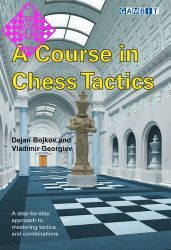 A Course in Chess Tactics17,95 €
A Course in Chess Tactics17,95 € -
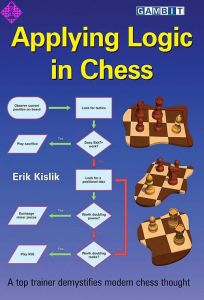 Applying Logic in Chess24,50 €
Applying Logic in Chess24,50 € -
 Chess Endgame Workbook for Kids17,50 €
Chess Endgame Workbook for Kids17,50 € - Mehr von Gambit

